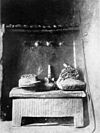Ogbanje
An ọgbanje is a term in Odinani (Igbo: ọ̀dị̀nànị̀) for what was thought to be an evil spirit that would deliberately plague a family with misfortune. Belief in ọgbanje in Igboland is not as strong as it once was, although there are still some believers.
Its literal meaning in the Igbo language is "children who come and go". Sometimes the word ọgbanje has been used as a synonym for a rude or stubborn child. The word ọgbanje is often translated as changeling, due to the similarities they share with the fairy changelings of Celtic and broader European mythology. Some theorists have hypothesized that these conceptions serve as mythological ways of understanding what were once unknown diseases that often claimed the lives of children (such as SIDS and sickle cell disease),[citation needed] as the inheritance of these diseases within families may have led people to conclude that the children involved were all incarnations of the same malevolent spirit.[1][2]
It was believed that within a certain amount of time from birth (usually not past puberty), the ọgbanje would deliberately die and then be reborn into the next child of the family and repeat the cycle, causing much grief. It is also believed that ọgbanje are born into the same immediate family all the time; it can even be born into an extended family. Ogbanje can be born into family from a spirit between gestation and birth.
Another way is by being introduced to an ọgbanje group. For example, a study[citation needed] mentions that a child was introduced into an ọgbanje group after the death of one of his siblings, and from there the child often came home late with his clothes ripped up. Eventually the child brought a weapon to school, at which point he confessed that he had been introduced into an ọgbanje group. According to another study[citation needed], a young boy committed suicide and left a note that blamed his sister for his suicide. The family started noticing an ọgbanje in the family when the child would return home late from school, and when they found weapons in the child's school bag. The child then went on to admit that he had been introduced to an ọgbanje group by his sister-- the same sister who was mentioned in the suicide note.
The evil spirits are said to have stones called iyi-uwa, which they bury somewhere secret. The iyi-uwa serves to permit the ọgbanje to return to the human world and to find its targeted family. Finding the evil spirits' iyi-uwa ensures the ọgbanje would never again plague the family with misfortune. The iyi-uwa is dug out by a priest and destroyed. The child is confirmed to no longer be an ọgbanje after the destruction of the stone, or after the mother successfully gives birth to another baby.[3] Female ọgbanje die during pregnancies along with the baby, while male ọgbanje die before the birth or death of a wife's baby.
To prevent the ọgbanje from returning after the child's death, they would be cut or mutilated. Some ọgbanje, however, were said to return bearing the physical scars of the mutilation.[4] Female circumcision was sometimes thought to get rid of the evil spirit.[5] Trying to identify an ọgbanje that lacks mutilation scars can sometimes be difficult. Other things that have helped families identify them are birthmarks the child had, the first words they said, and behavior similarities from the child that has been reincarnated. Families paid a lot of attention to these types of characteristics, and most of the time would go to an oracle to confirm that the child was an ọgbanje. Another sign of an ọgbanje is a child who frequently becomes very ill, or is often in trouble.
In popular culture[]
- In the critically acclaimed novel by Chinua Achebe, Things Fall Apart (1958), the character Ezinma was considered an ọgbanje because she was the first of 10 children born to her mother that did not die in infancy.[4][6]
- In the novel Freshwater by Akwaeke Emezi (2018), the main character, Ada, contains multiple ọgbanje.[7]
See also[]
References[]
- ^ Ọnwụbalịlị JK (August 1983). "Sickle-cell anaemia: an explanation for the ancient myth of reincarnation in Nigeria". Lancet. 2 (8348): 503–5. doi:10.1016/s0140-6736(83)90524-x. PMID 6136656.
- ^ Nzewi E (May 2001). "Malevolent ọgbanje: recurrent reincarnation or sickle cell disease?". Soc Sci Med. 52 (9): 1403–16. doi:10.1016/S0277-9536(00)00245-8. PMID 11286364.
- ^ Nnam, Nkuzi Michael (2007). Colonial Mentality in Africa. Hamilton Books. pp. 69–70. ISBN 1461626307.
- ^ Jump up to: a b Chinua Achebe .
- ^ Sarkis, Marianne. "NIGERIA: Female circumcision in Igboland". www.fgmnetwork.org.
- ^ "Yahoo". Yahoo. Archived from the original on 2008-05-02.
- ^ Emezi, Akwaeke (2018). Freshwater. Grove Press. ISBN 978-0802128997.
- Igbo religion
- West African legendary creatures
- Nigeria mythology
